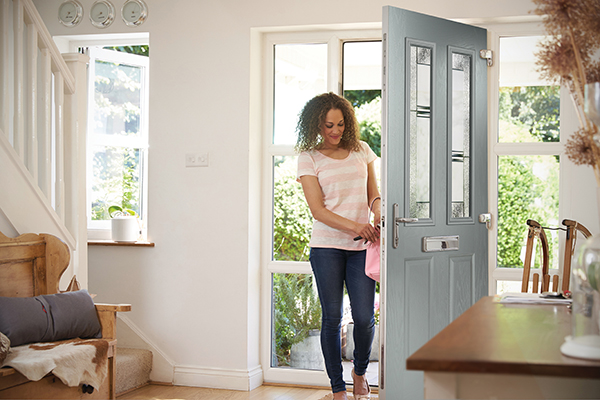Security
In 2015 the Government issued a new Approved Document for use in England called ‘Approved Document Q – Security – Dwellings’ (AD Q). This new guidance is only applicable to new dwellings (mainly houses and flats newly built or formed as the result of change of usage of an existing building). The requirements do not apply to replacement windows being installed in existing dwellings or new extensions added to existing dwellings.
AD Q requires easily accessible windows and doors[1] that provide access in any of the following circumstances:
- Into a dwelling from outside
- Into parts of a building containing flats from the outside
- Into a flat from common parts of a building: to
Resist physical attack by a casual or opportunist burglar by being both:
- Sufficiently robust
- Fitted with appropriate hardware
In terms of doorsets, the requirement includes any garage doorset and communal entrance doorsets that provide access into a dwelling or into a building containing a dwelling and these doorsets should be secure doorsets.
The secure doorsets should either be:
- Manufactured to a design that has been shown by test to meet the security requirements of British Standards publication PAS 24:2012[2], or
- Designed and manufactured in accordance with Appendix B[3]
NOTE: Doorsets satisfying other standards that provide similar or better performance are also acceptable. These standards include:
- STS 201 Issue 5:2013
- LPS 1175 Issue 7:2010 security rating 2
- STS 202 Issue 3:2011 burglary rating 2
- LPS 2081 Issue 1:2015 security rating B
- Accessible windows and door are defined in Appendix A as ‘either and window or doorway, any part of which is within 2 metres vertically of an accessible level surface such as the ground or basement level, or an accessible balcony’ or ‘a window within 2 metres vertically of a flat or sloping roof (with a pitch of less than 30°) that is within 3.5 metres of ground level.
- It must be noted that this does allow doorset manufacturers to use Cascaded test information, e.g., from a Systems House and they do not need to carry out their own testing to PAS 24 or alternative.
- Appendix B contains a specification specifically for timber doorsets that have not been subjected to testing
__________________________________________________________
Accessible windows and door are defined in Appendix A as ‘either and window or doorway, any part of which is within 2 metres vertically of an accessible level surface such as the ground or basement level, or an accessible balcony’ or ‘a window within 2 metres vertically of a flat or sloping roof (with a pitch of less than 30°) that is within 3.5 metres of ground level.
It must be noted that this does allow doorset manufacturers to use Cascaded test information, e.g., from a Systems House and they do not need to carry out their own testing to PAS 24 or alternative.
Appendix B contains a specification specifically for timber doorsets that have not been subjected to testing
In addition to the requirements detailed above:
- letterplates are restricted in aperture size and should be located on the doorset to hinder anyone attempting to remove keys with sticks and /or insert their hand
- Letterplates meeting the requirements of the Door and Hardware Federation’s (DHF) technical specification TS 008:2012 have been shown to protect against the attacks mentioned above.
- The main doors for entering a dwelling (usually the front door) should have a door viewer unless other means exist to see callers, such as clear glass within the door or a window next to the doorset. The same doorset should also have a door chain of door limiter.
AD Q also requires all accessible doorsets and adjacent glazing (side and over lights) should contain at least one pane of laminated glass with a classification from BS EN 356 testing of P1A or better.
AD Q also states that:
- Laboratories accredited by the United Kingdom Accreditation Service (UKAS) or an equivalent European national accreditation body should have the necessary expertise to conduct the relevant tests.
- Any test evidence used to confirm the security of a construction should also be carefully checked to ensure that it demonstrates compliance that is adequate and that applies to the intended use. Evidence passed form one organisation to another (cascaded evidence) can become unreliable if important details are lost. Small differences in construction can significantly affect the performance of a doorset or window.
- Schemes that certify compliance with PAS 24:2012 or other standards that offer similar or better performance may be acceptable for demonstrating compliance. A list of UKAS accredited certification bodies is given on the UKAS website.
The above is applicable at the time of writing, May 2022 and the references to PAS 24 relate to the 2012 version. Since this time a 2016 version has been published and PAS 24 is currently undergoing a further 2022 revision. The draft for public comment is available until 27th May 2022 and the final version is expected to be published in late summer 2022.
AD Q is also undergoing a revision and the primary change is expected to be the inclusion of replacement windows and doorsets being installed in existing dwellings in AD Q requirements. A consultation is expected during the summer 2022 and publication by the end of 2022.
The requirements in Wales are similar to those in England using AD Q published by the Welsh Government.
The requirements in Scotland are given in section 4.13 of the ‘Building standards technical handbook 2019: Domestic’. The requirements are again based on PAS 24 but the 2007 version.
Northern Ireland do not currently have any requirement for security of windows and doorsets.

